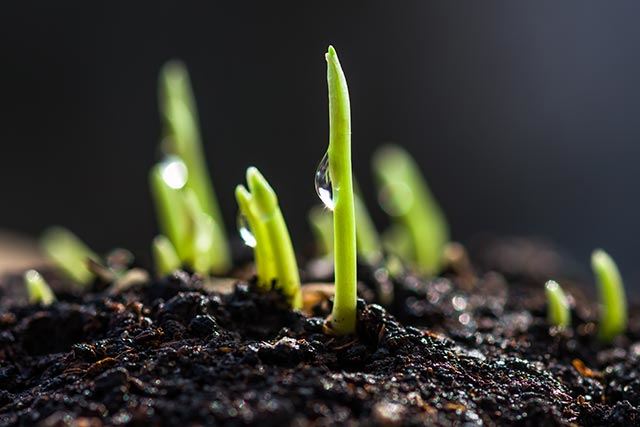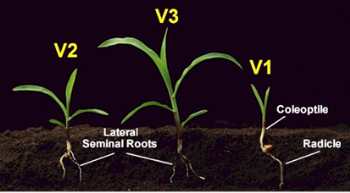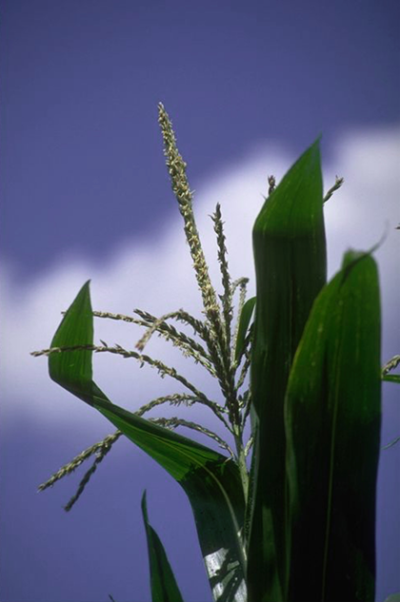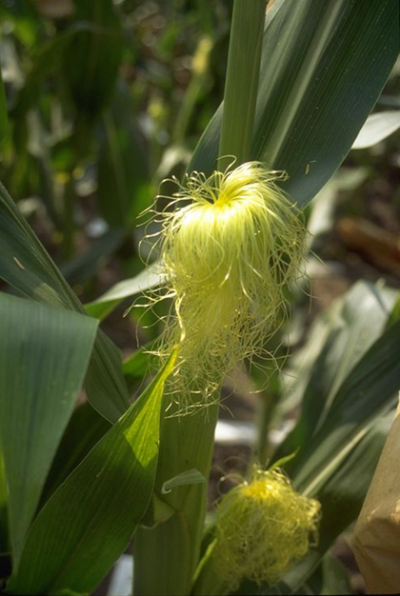Corn Growth Stages And Growing Degree Units
Apr 13, 2020

-
A corn plant requires a certain number of growing degree units (GDUs) to reach maturity, regardless of the number of calendar days it takes to accumulate.
-
The relationship of GDU accumulation and corn development, along with utilizing the estimated number of days to reach a certain growth stage, can help predict when important growth stages will occur.
-
Growth stages can be used to help growers make timely applications of herbicides and fungicides. The following information is on corn growth and development from emergence to R6 growth stage.
Corn growth stage development can vary according to corn maturity. An early maturing pro
EMERGENCE AND STAND ESTABLISHMENT (VE TO V9)
As soon as corn seed is planted into soil, metabolic reactions begin to take place within the seed. With adequate moisture and soil temperatures above 50° F, the radicle will begin to elongate from the corn seed. Emergence of the radicle from the seed is called germination, which may occur from 2 to 3 days after planting or after 65 to 80 GDUs have accumulated. Germination may take several days longer depending on soil moisture, soil temperature, residue on the soil surface, and planting depth of the seed.
VE Stage. Corn emergence (VE stage) is achieved when the coleoptiles reach and break through the soil surface. Normally corn requires approximately 100 to 120 GDUs to emerge, which under favorable conditions can be 4 to 5 days after planting.1 If cool or dry conditions exist, emergence may be delayed several weeks. At the VE stage, growth is also taking place below the soil surface as the nodal root system begins to grow. At approximately 6 weeks, the nodal root system will replace the work of the lateral seminal roots in supplying the plant with water and nutrients.
Problems may occur prior to emergence. One preemergence problem that can occur is when coleoptiles rupture below the soil surface. This makes it difficult for the seedlings to break through the soil surface, resulting in seedlings that are yellow, twisted, or “leafout65533;? below ground. Reasons for this may include cloddy soil, herbicide injury to the seedling, soil crusting, or extremely cold soil temperatures.
V1 Stage. The V1 stage is reached when the first leaf has fully emerged and the leaf collar is visible. The V1 stage typically occurs 3 to 4 days after emergence. The first leaf to emerge will have a rounded tip, while all leaves that emerge later will have more pointed tips.
V2 Stage. The V2 stage occurs when two leaves are fully emerged with collars visible. The V2 stage occurs typically 7 to 10 days after emergence or around 200 GDUs.2

V3 Stage. The V3 stage marks the end of the seed being the main food source and the beginning of the photosynthetic process. The V3 stage is reached at 10 to 20 days after emergence or at around 350 GDUs.2 At the V3 stage, the plant begins to rely more on the nodal root system as these roots form root hairs and continue to increase in size. Growth of the seminal root system has ceased.
V4-V6 Stage. During these stages the uppermost ear and tassel is initiated and kernel row numbers are determined. The growing point of the corn plant is near the surface. The V6 stage occurs at approximately 475 GDUs.2
V7-V9 Stage. These stages begin the rapid growth phase. If the corn plant is stressed, lower leaves may die. At approximately 610 GDUs, 8 leaves will have formed.2
RAPID GROWTH AND DRY MATTER ACCUMULATION (V10 TO V17)
During the V10 to V17 growth stages, any management practice that helps reduce plant stress and allows for adequate nutrient levels can help maximize yield potential.
V10 Stage. At 740 GDUs, 10 leaves have formed, the corn stalk elongates, and the tassel rapidly grows during this phase.2
V11-V15 Stage. At V12, kernel row determination is almost complete. As the plant nears pollination, soil moisture and nutrient availability becomes increasingly critical for yield determination.
POLLINATION (V18 TO R1)
Pollination begins around 9 or 10 weeks after corn emergence. Moisture and heat stress during pollination may cause the greatest yield reduction, which can result in barren tips or loss of entire ears.
VT Stage. Tassel stage begins when the last branch of the tassel is visible, but silks have not emerged (Figure 2). This occurs after the accumulation of approximately 1135 GDUs.2Tassels normally appear 2 to 3 days before silk emergence. Pollen shed typically occurs in the morning or evening.

Figure 2. Corn plant at tassel or VT growth stage.
R1 Stage. The silking stage begins when the silk is visible outside the husk (Figure 3). Pollen falls onto the silks to potentially fertilize the ovules. Each ovule can produce an individual kernel. Moisture stress at this time can cause the desiccation of silks and/or pollen grains, which could reduce seed set.

Figure 3. Corn plant at silking or R1 growth stage.
GRAIN FILL (R2 TO R6)
Grain fill is the last set of stages of the corn growth cycle. The plant now directs nutrients for reproductive growth instead of vegetative growth. While the number of kernels has already been determined in earlier stages, the size of the kernels is set during grain fill stages. Frost or freezing before black layer maturity may prematurely kill a plant, which will slow drydown, reduce grain quality, and final yield potential.
R2 Stage. The blister stage is approximately 10 to 14 days after silking at 1660 GDUs.2 During this stage the kernel is white and shaped like a blister.
R3 Stage. Milk stage (18 to 22 days after silking), the kernel is yellow with a white milky inner liquid. At this stage dry matter accumulation is very rapid. Silks on the corn ear are brown and dry.
R4 Stage. During the dough stage (24 to 28 days after silking/1925 GDUs) the inner fluid begins to thicken due to starch accumulation. The kernels will have accumulated half of their total dry weight.
R5 Stage. At dent stage (35 to 42 days after silking/2190 to 2450 GDUs) the kernels begin to dry down from the top of the kernel towards the cob. Each kernel will have a dent at the top. If a frost occurs during this stage, the black layer can form prematurely preventing additional dry matter accumulation.
R6 Stage. The kernels continue to gain weight until black layer formation or physiological maturity (55 to 65 days after silking/approximately 2700 GDUs) occurs. The black layer forms where the kernel attaches to the cob. Kernel moisture is at 30 to 35 percent.
SOURCES:
1Abendroth, L.J., Elmore, R.W., Boyer, M.J., and Marlay, S.R. 2011. Corn Growth and Development. PMR 1009. Iowa State University Extension.
2Neild, R.E. and Newman, J.E. 1990. Growing season characteristics and requirements in the Corn Belt. National Corn Handbook, Purdue University, Cooperative Extension Service, West Lafayette, IN.
Information provided by https://www.dekalbasgrowdeltapine.com/en-us/agronomy/corn-growth-stages-and-growing-degree-units.html?cid=monDM4341&bid=8293434